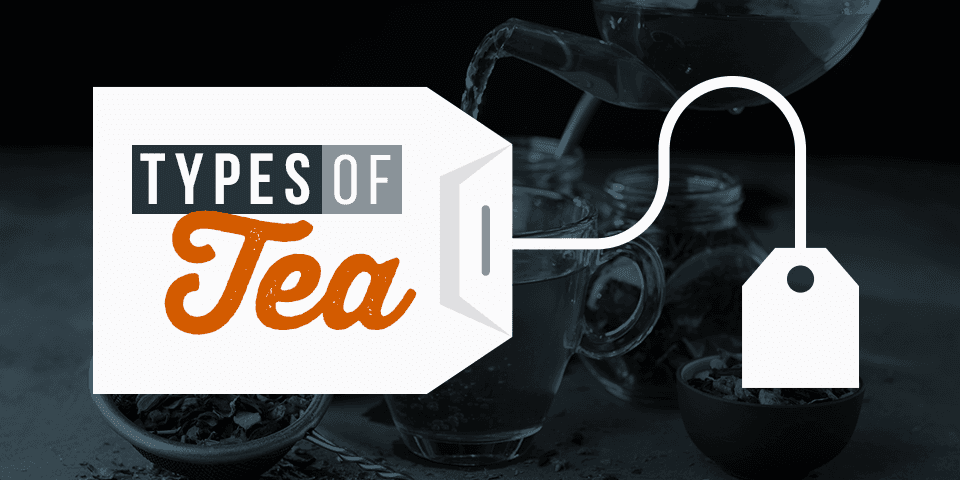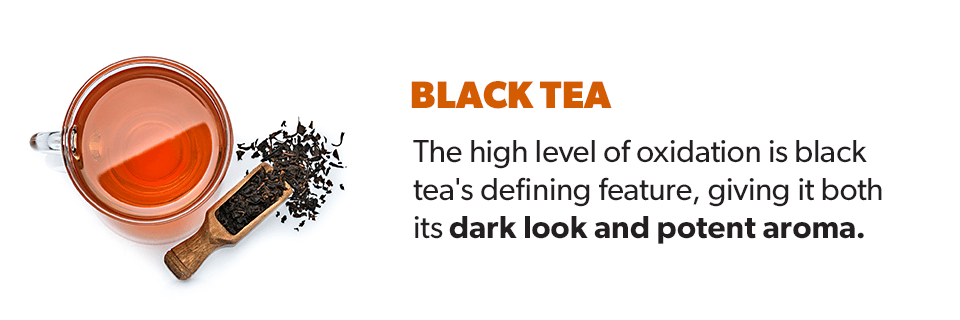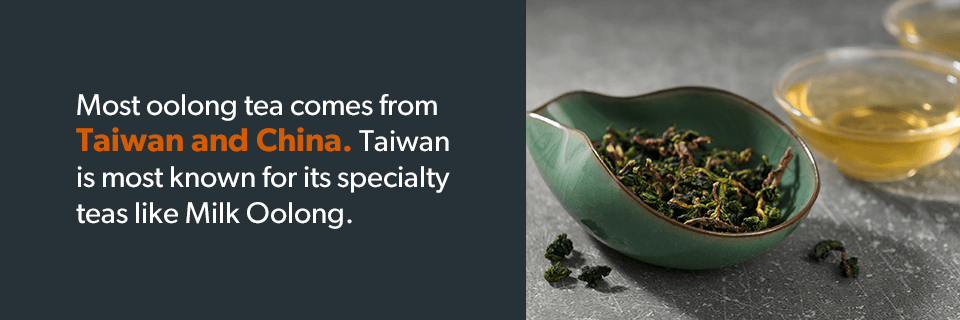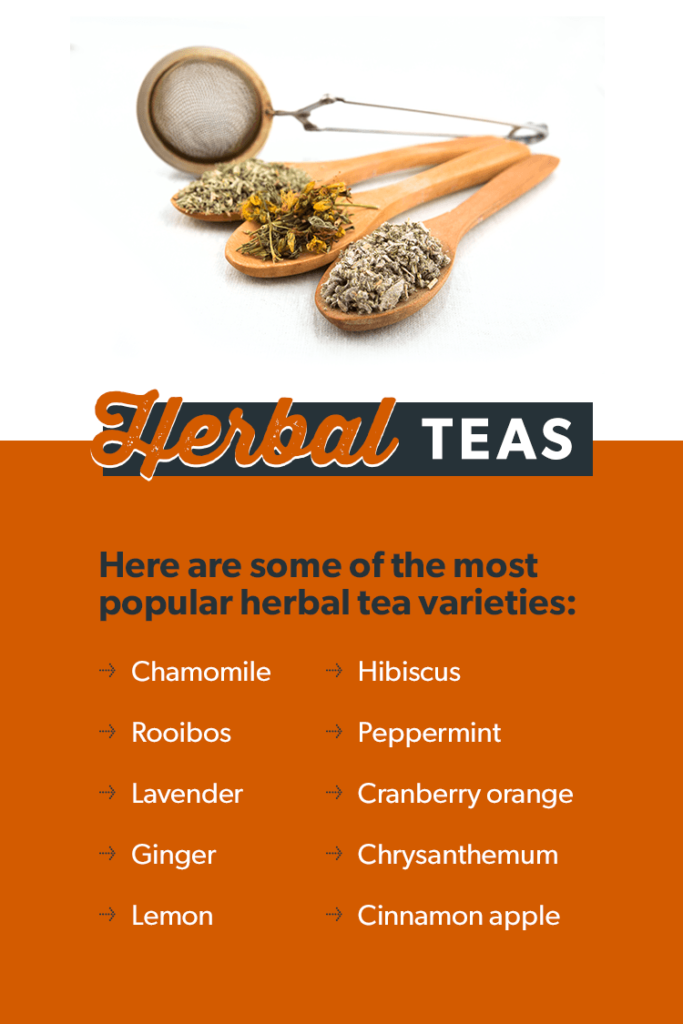
Anyone interested in breaking into the tea market needs to be familiar with all the different types of tea flavors. With thousands of teas out there, it can be easy to get lost in the details of where each one comes from and what it tastes like. Keeping track of all the popular types of tea can be a challenge, even for a tea connoisseur.
Knowing the different tea types, how they’re processed, and what health advantages they could offer will help you choose a tea product or blend that’s in demand. Keep reading for everything you need to know about the different types of tea and their benefits to make smart beverage business choices.
Explore Our Available Coffees and Teas
Do Tea Leaves All Come from the Same Plant?
Despite all the styles and flavors when you walk down the tea aisle, every type of tea comes from the same plant — the Camellia sinensis plant, one of the oldest plants in the world. While this evergreen shrub can grow extremely tall in the wild, it is typically kept to a height of about three or four feet when cultivated for tea harvest.
Originally, Camellia sinensis grew in the wild like a tree. Nowadays, most of these tea bushes grow in neat rows on tea plantations. Although tea plants generally live 30 to 50 years, they can grow for thousands of years. An estimated 3,200 years old, the Jinxiu Tea Tree in China is famous for being one of the oldest tea trees and is protected as a living fossil.
Just as wine comes from numerous varietals of grapes, there are different varietals of Camellia sinensis. There are thousands of different cultivars, and their variations have a distinct impact on the final tea’s aroma, scent, color, flavor, and other characteristics. Ultimately, what your cup of tea tastes like depends on which varietal of Camellia sinensis it stems from.
How Many Types of Tea Are There?
You can find thousands of tea varieties available these days, each offering its own unique characteristics and nuances. Naming these types of tea is similar to how wine is named — after the region where it’s grown. Like Champagne is produced in the province of Champagne, Yunnan tea gets its name from the Chinese province of Yunnan.
The climate and soil conditions where the tea is grown drastically affect the final product in the kettle. How the maker processes the tea largely determines its flavor characteristics. With so many variables at play, it’s easy to create a wide variety of tea tastes.
What Is Tea Terroir?
Essentially, tea terroir is the biotic and physical environment that surrounds and affects a tea plant. The idea behind terroir is that the flavor of a specific tea extends beyond the genetic makeup of the tea shrub varietal or even the way the leaves are processed. The terroir also plays a key role in the beverage’s final taste.
Terroir means that the specific soil and weather conditions the tea is grown in can cultivate certain flavors and aromas. Different tea-growing regions of the world produce distinct flavors unique to their location. Understanding the components of terroir helps us appreciate all that goes into crafting a delicious tea.
The biggest factors of terroir include:
- The soil composition: The soil’s composition and chemistry are so important that even the dissolved mineral content of the water that nourishes the plant affects the plant. For example, the mineral levels in a region’s soil can have a notable impact on how strong its tea tastes.
- The local ecosystem: The environment surrounding the tea plant influences its flavor notes. Specifically, tea shrubs can absorb some of the flavors and aromas of other plants growing near them. For instance, tea shrubs growing on a mountain covered in flowers produce tea with floral notes.
- The weather: The weather and climate of an area also impact a tea’s flavorings. For example, the amount of sunlight a tea shrub receives affects the strength of its leaves’ flavor. Elevation is also related to weather, with higher, colder elevations producing sweeter teas.
Explore Our Available Coffees and Teas
The 6 Different Types of Tea and Their Benefits
Although there are thousands of teas on the market, each of these teas can be classified into one of six main categories:
- Black tea
- Green tea
- White tea
- Oolong tea
- Yellow tea
- Pu-erh tea
Using these six categories as a simple classification system makes it easier to package and discuss similar teas. Discover the details of these six common types of tea, including their regions, processing methods, brewing techniques, taste, and associated health benefits.
1. Black Tea

Also referred to as “red tea” in China, black tea is the darkest, boldest type of tea. It owes its dark coloring to the way the plant is harvested and the oxidation process. Once farmers have plucked the leaves from the plant, they process the clippings into the dried packages we use to make tea. The amount of oxygen the tea leaves are exposed to throughout this process is known as oxidation and determines the tea’s classification.
Black tea gets withered, fully oxidized, and dried for a remarkably long time. This high level of oxidation is black tea’s defining feature, giving it both its dark look and potent aroma. The standard flavor profile of black tea is strong, brisk, and full-bodied, with varying degrees of maltiness or fruitiness.
There is no such thing as a universal black tea flavor because all the growing regions are massively distinct. Although it got its start in China, producing black tea is now a staple of former British colonies, including India, Kenya, and Sri Lanka, which have mastered the art of harvesting black tea and expertly blending it with other ingredients to create classic tea styles like masala chai and earl grey.
The best method for bringing out black tea’s bold flavor is boiling water and allowing the tea to steep. This technique delivers the most caffeine per cup, along with many other advantages. Some of the top health benefits associated with black tea include:
- Decreased risk for heart attacks
- Lower cholesterol
- Decreased blood pressure
- Obesity management or prevention
2. Green Tea
Unlike black tea, green tea hardly undergoes any oxidation. To avoid oxidizing the tea leaves when processing green tea, harvesters fire the leaves — briefly subject them to intense heat to neutralize the oxidation enzymes — as soon as they pick them. Although other types of tea go through the firing process, green tea is the only type that undergoes firing as its first step, which prevents oxidation.
Green tea is mainly produced in China and Japan. Each of these countries has its own signature way of making its green tea. Chinese green teas get pan-fried with dry heat to prevent oxidation, whereas Japanese green teas get steam-fried with wet heat. These two processes produce strikingly different results that make it easy to recognize which region a green tea comes from.
Green tea is a lighter tea with a natural green hue. This refined process gives it a more delicate, fresh, and somewhat grassy flavor to go along with its paler appearance. Steeping your green tea at a lower temperature for a shorter amount of time keeps it from tasting too bitter or astringent.
When you sip a cup of green tea, you could also enjoy these associated health benefits:
- Improved mental alertness
- Lessened digestive symptoms
- Reduced headaches
- Weight loss
- Epigallocatechin-3-gallate (EGCG), which may help prevent cancer and heart disease
3. White Tea
White tea is another tea variety with an incredibly light oxidation level. Producing white tea starts with harvesting the tiny baby buds of a tea shrub, then processing them as little as possible. The only direct action taken upon the tea leaves is slowly and methodically drying them to reduce moisture until the desired aroma and flavor are achieved.
Due to this delicate process, white tea boasts a unique, sweet aroma and a soft, fresh flavor that tastes straight from the garden. Although similar to green tea, white tea is typically creamier, sweeter, and softer than green tea. White tea doesn’t become bitter or astringent easily, so you don’t need to be too careful about how you steep it. How long you do so determines its caffeine level.
White tea’s precise flavors vary depending on the region it comes from and its oxidation. Flavors of less-oxidized white tea tend to be bright, fruity, and herbaceous, while more-oxidized versions are woodsy, nutty, and spicy. Primarily, white tea comes from China, but you can also find blends from Taiwan, Sri Lanka, and Nepal.
In case you need any more convincing before reaching for some white tea, here are the health benefits white tea could offer:
- Reduced cholesterol levels
- Antioxidants that get rid of free radicals and help prevent cancer
- Lower stress
- Increased metabolism
- Healthier skin and bones
- Strengthened immune system
4. Oolong Tea

Oolong is another tea similar to green tea that has been only partially oxidized. The partial oxidation process leaves room for plenty of style variations, but each style shares the same long transformation process of withering, shaking, pan-firing, rolling, drying, and baking.
This lighter oxidation process gives oolong tea a fresh taste with a distinct flavor dependent on where the tea leaves were grown. Most oolong tea comes from Taiwan and China. One popular oolong tea comes from the Chinese tea-producing provinces in the Wuyi Mountains and Anxi. Taiwan is most known for its specialty oolong teas like Milk Oolong.
These regions follow the traditional method of preparing oolong tea with large amounts of leaf in smaller steeping vessels for multiple short steeps. Making oolong tea this way brings out the deeper flavors of the tea, along with some floral, sweet, grassy, or toasty notes.
As a bonus, your cup of oolong tea could help you live a healthier lifestyle through:
- Reduced risk of chronic diseases like heart disease
- Decreased chances of developing cancer or having a stroke
- A metabolism boost to help with weight management
- Antioxidants that help repair DNA damage
5. Yellow Tea
Of all the types of tea, yellow tea is the rarest. The yellow tea production process is similar to green tea but involves drying the tea leaves more slowly, giving them a more yellow coloring. Commonly referred to as “sealed yellowing,” this procedure increases the leaves’ oxidation level while removing the strong grassy smell generally associated with green tea.
This drawn-out drying process gives yellow tea a mild taste somewhere between the flavor profiles of green and white tea. While yellow tea has the same mellow flavor as green, it has a smoother taste and a more fruity and floral aroma. In this way, yellow tea’s flavors match its bright appearance.
This lightly fermented, lesser-known tea is unique to China and has yet to catch on in many other places across the globe. Although not as widely recognized as most other teas, it could soon see a rise in popularity thanks to its possible health benefits, such as:
- Anti-inflammation properties
- Antioxidants that help fend off free radicals
- Lower stress on the body
- Reduced risk of stroke
- Anti-cancer characteristics
6. Pu-erh Tea
Pu-erh is another type of tea exclusively from China. More specifically, pu-erh tea comes from a southern region in the Yunnan province, the only place you can find its ideal growing conditions. You can get either raw or ripe pu-erh, which are differentiated by the way they are processed.
After farmers harvest, wither, fire, roll, and dry the raw pu-erh, they press it into tea cakes and place them in a temperature- and humidity-controlled environment to age for up to decades. Ripe pu-erh goes through an accelerated aging process called wet-piling that involves spraying piles of the tea leaves with water before leaving them in a hot and humid space to dry. After several weeks, the ripe pu-erh gets pressed into tea cakes and dried further.
Pu-erh is most famous for its rich, earthy flavor. While raw pu-erh can have a range of flavors depending on how far along it is in the aging process, the flavor variations for ripe pu-erh are more limited. In general, pu-erh has a smooth, floral, and earthy taste with a full-bodied texture.
Pu-erh is another tea that is highly regarded for its positive health associations, such as:
- Boosted liver function
- Anti-cancer properties
- Improved cholesterol levels
- Weight loss
Explore Our Available Coffees and Teas
What Is Herbal Tea?

Despite its name, herbal tea is not technically tea because it doesn’t come from the Camellia sinensis plant. Although not tea in the truest sense of the word, herbal tea is similar to regular tea because it involves steeping earth ingredients in boiling water to produce a delicious, healthy beverage.
Instead of Camellia sinensis, herbal tea uses dried botanicals like flowers, barks, fruits, herbs, spices, roots, berries, seeds, and basically any other type of edible plant. Although herbal tea can feature just one of these ingredients, it most often combines many botanicals for a unique blend. Because herbal teas are made from caffeine-free ingredients, they are great to sip before bed.
Here are some of the most popular herbal tea varieties:
- Chamomile
- Rooibos
- Lavender
- Cranberry orange
- Ginger
- Lemon
- Hibiscus
- Peppermint
- Chrysanthemum
- Cinnamon apple
Explore Our Available Coffees and Teas
Find the Perfect Tea for You at Joe’s Garage Coffee
If you’re ready to start offering tea products, find the best tea flavor for you at Joe’s Garage Coffee. We provide a wide variety of teas, so you’ll have no problem finding one that fits your brand. Regardless of what market you’re catering to, they’ll love the rich flavors found in our house tea blends.
To learn more about our tea products and blends, contact Joe’s Garage Coffee today.









